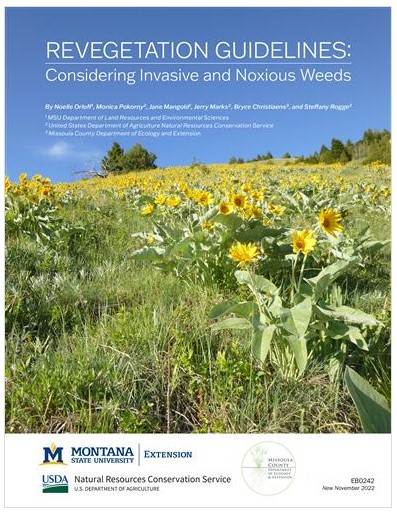Revegetation Guidelines: Considering Invasive and Noxious Weeds
Introduction

Revegetation, the intentional planting of desired species, is an important component of integrated weed management. Weed control without revegetation can be short-lived if desired plants are not available to occupy open spaces created after weeds are killed. Establishing desired species that meet land management goals and compete with re-invading weeds is critical for long-term weed management. Revegetation is not a simple task, however, and many plantings fail due to weed encroachment and other complicating factors. The new publication Revegetation Guidelines: Considering Invasive and Noxious Weeds outlines seven steps for planning a revegetation project.
Step 1: Site Assessment
Evaluate characteristics of the area to be revegetated. Consider climate, landscape position (e.g., elevation, slope, aspect, hydrology), soil characteristics, existing vegetation, and accessibility for equipment at the planning stage to improve the likelihood of success.
Step 2: Determine Project Goals and Objectives
Goals should describe how the land will be used and what the land can support. Objectives should be measurable links between goals and revegetation actions, for example, “Reduce weed cover by 20% and increase native grass cover by 10% one year after spraying and seeding.”
Step 3: Control Weeds
Controlling weeds before, during, and after revegetation helps reduce weed competition with seeded species. Different control methods have unique advantages and disadvantages when integrated with revegetation and should be considered on a site-specific basis. In general, though, weeds are prolific seed producers and will continue to emerge from the seed bank. Controlling weeds will likely be necessary even after revegetation.
Step 4: Planning a Seeding
This is arguably the most complex part of revegetation. It includes selecting species; putting together the seed mix; and determining the seeding rate, method, and timing. These are decisions that take much thought and play a large role in whether revegetation succeeds.
Step 5: Site Preparation and Implementation
Much time and effort have gone into the revegetation process thus far, and good site preparation improves the chances that revegetation will be successful.The overarching goal of this step is to prepare the site to achieve the best contact between seeds in the seed mix and soil at the site and may include actions like shallow chiseling, harrowing, or discing.
Step 6: Monitor Establishment
Monitoring involves periodically assessing vegetation growing at the site to see if it is on track to meet management goals and objectives and can range from a quick visual inspection to an in-depth recording of species composition and abundance. Seeded species, especially native species, may take several years to establish and become dominant, so patience is necessary.
Step 7: Long Term Management
Long-term management is important to maintain a healthy plant community that favors growth of desired species over that of weeds.Periodic monitoring, implementing weed control as needed, and managing grazing (if applicable) are key aspects of long-term management.
For in-depth information about each of these steps, see the new publication.
Further Information
For more information about this month's weed post, contact Extension Invasive Plant Specialist Jane Mangold. Past posts are available in the Monthly Weed Post Directory.
This weed post is also available as a printable PDF (141 KB).
